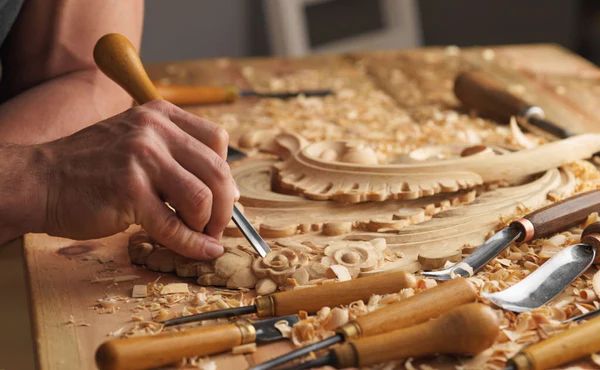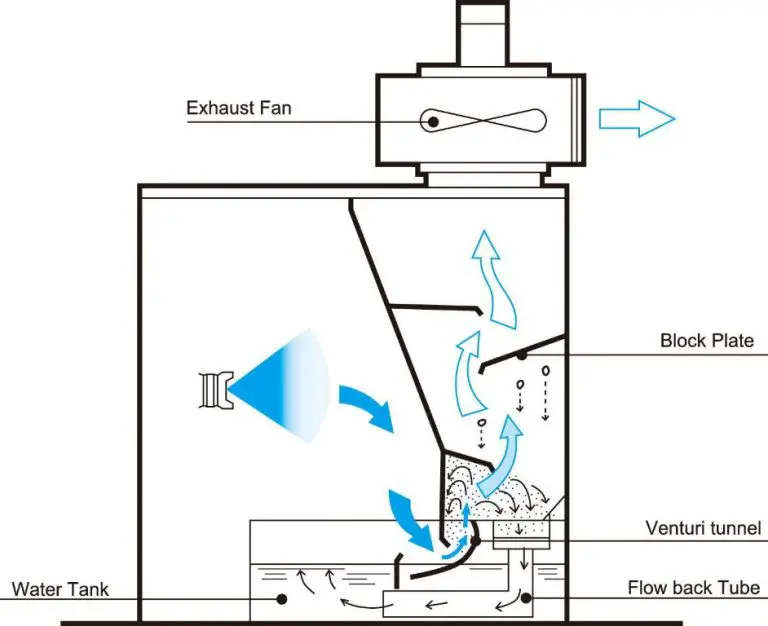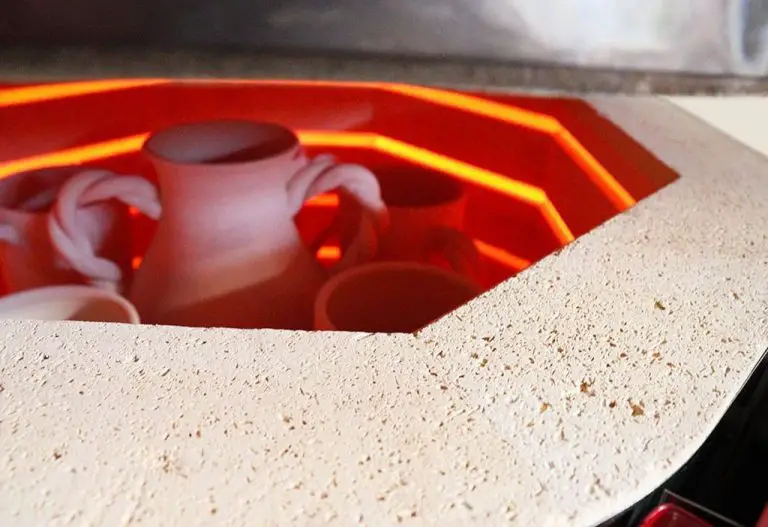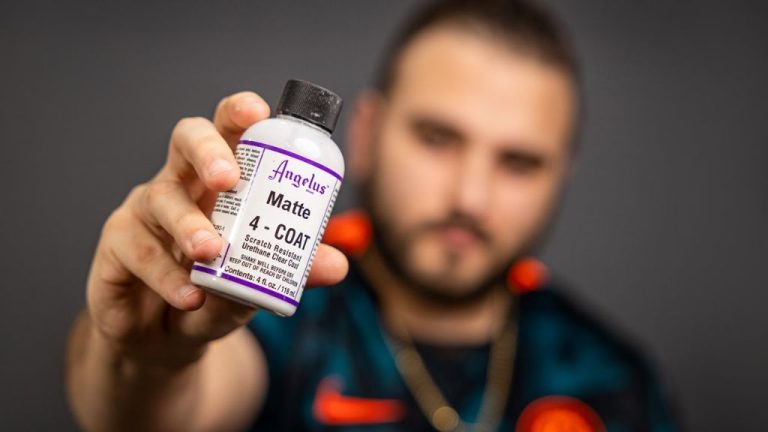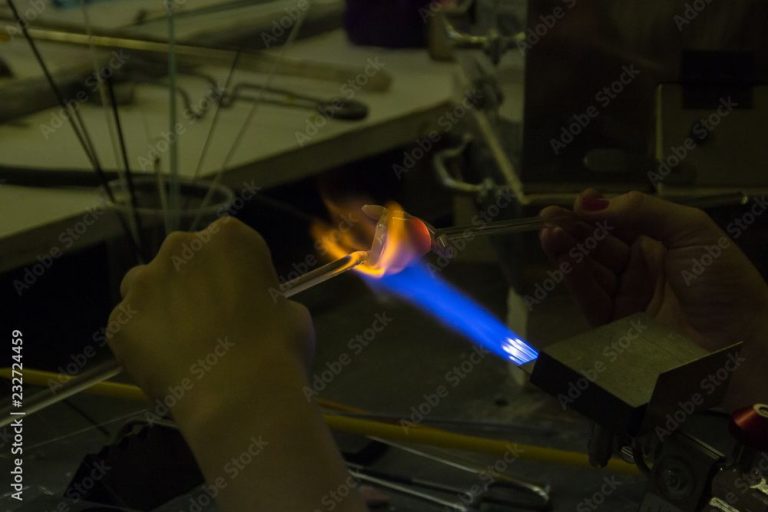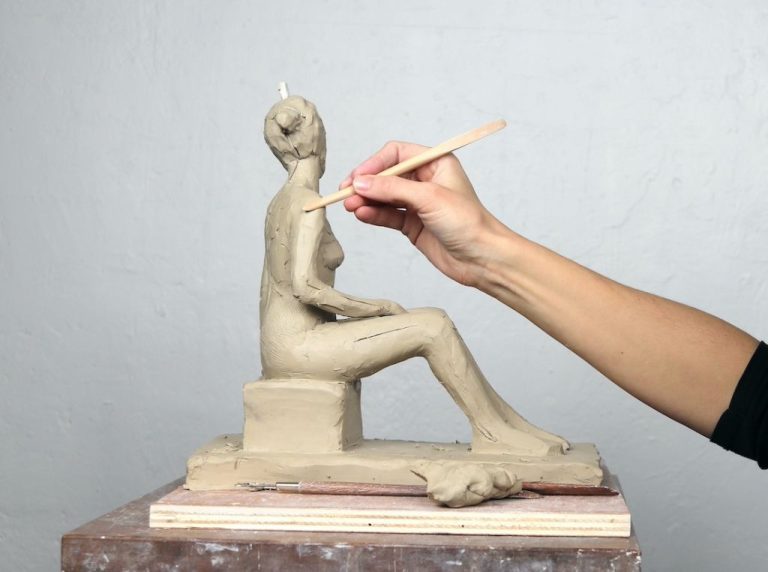How Is Horse Hair Used In Raku?
Raku pottery dates back to the 16th century in Japan and was originally used for the tea ceremony. The style was developed by Chōjirō, who was the founder of the Raku family of potters. The name “Raku” comes from the Japanese word meaning “enjoyment” or “comfort.”
Raku ware is characterized by its simple, hand-formed shapes and tactile, lead glazed surfaces. The pottery is low-fired and removed from the hot kiln while still glowing hot. This firing process, along with the fast cooling, produces the unique crackled glaze effect of raku. The pottery has an earthy, organic aesthetic that aligns with traditional Japanese values of wabi-sabi and mindfulness.
The unpredictability of the fast-firing process means that each raku piece has its own distinct character, with accidental effects adding to the charm. Raku pottery perfectly captures the Zen Buddhist principles of accepting imperfection and finding beauty in the transient. Today, raku remains a popular choice for tea ceremony items as well as contemporary artworks across the globe.
Making Raku Glazes
Raku glazes are an essential component of raku pottery. They differ from standard glazes due to the unique raku firing process. Raku glazes are formulated to withstand the thermal shock of rapid cooling during firing. Key ingredients in raku glazes include:
Clays – Raku glazes often use fire clays that can withstand high temperatures, such as raku, stoneware, and porcelain. These provide strength and structure to the glaze.
Fluxes – Fluxes such as calcium carbonate, dolomite, or feldspar are added to lower the melting point of the glaze. This allows the glaze to melt and fuse to the clay body during firing.
Colorants – Metal oxides like copper, cobalt, and iron are used to introduce color effects. Carbon or silicone carbide can create crackle effects. Stains and underglazes also introduce color.
Opacifiers – Ingredients like zirconium oxide, tin oxide, and titanium dioxide create opacity in glazes. They prevent the body from showing through transparent glaze.
The raku firing process involves rapid heating up to 1600-1800°F to melt and fuse the glaze followed by sudden cooling. Pieces are removed from the kiln while red hot and placed into containers with combustible materials. This creates special effects from crackling, crazing, and carbon trapping.
Raku glazes require specialized development and testing to withstand thermal shock. Variations in clay bodies, kilns, and firing methods impact results. Most potters develop their own recipes over years of experience and experimentation (Caldwell, 2022). The unique properties and firing process make raku glazes distinct from other ceramic glazes.
Using Horsehair in Raku
Horsehair is a popular material used in raku pottery for its distinctive crackle effects. When the horsehair makes contact with the super-heated raku pottery, it instantly burns and vaporizes, leaving behind carbon trails and deep crackle lines on the surface (Source). The horsehair reacts to the heat and shrinks rapidly, causing cracks and crazing in the areas it touches. As the hair burns, it pulls on the surface and stretches the clay, creating chaotic patterns.
The carbon left behind by the burning hair integrates with the glaze and clay body to create dark black crackle lines amidst the glaze colors. The length and thickness of the hair impacts the depth and detail of the crackle lines. Longer, coarser horsehair tend to create bolder crackle effects, while finer hair can produce delicate trails. Raku artists use horsehair strategically to create spontaneous yet controlled designs on their pottery. The cracking patterns are unique to each piece.
Horsehair raku requires careful timing, as the pot must be removed from the raku kiln at just the right moment when the glaze has softened and the clay is red hot. This allows the hair to produce a strong crackle reaction before the piece cools. The timing, glaze chemistry and the hair itself all affect the final crackled aesthetic.
Preparing the Horsehair
The first step in using horsehair in raku pottery is gathering and preparing the hair. Horsehair can be gathered by brushing horses, especially when they are shedding their winter coats in the spring. The hair should be collected in a bag or container to keep it clean and untangled.
Once enough hair has been gathered, it should be washed thoroughly in warm water and a mild detergent or shampoo to remove any dirt, oils or debris. Allow the hair to air dry completely before using it. Some artists recommend soaking the hair in vinegar or a solution of vinegar and water which helps remove additional oils and residues.
The hair can be used whole or cut into pieces. Longer strands will give more dramatic lines while small clippings create finer effects. The hair should be detangled and any short fuzzy pieces discarded. For more control, the hair can be separated into bundles or taped onto sticks before applying to the pottery.[https://www.lucktaylorceramics.co.uk/blog/2021/2/13/horsehair-raku-in-action]
Applying Horsehair
Laying horsehair onto raku pottery takes some technique to get the desired effect. The key things to focus on when applying horsehair are:
Preparation – The horsehair should be clean and prepared into bundles or strands before applying to the pottery. This makes it easier to lay on the surface cleanly.
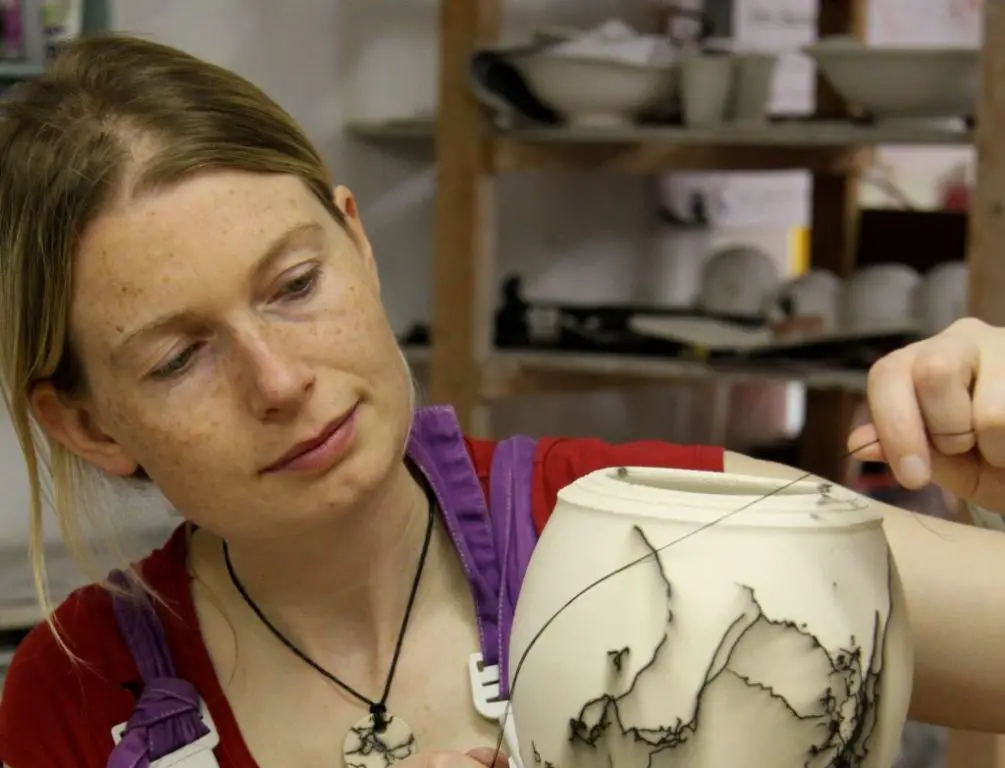
Timing – The pottery must be at the right temperature, around 800-1000°F, for the hair to burn effectively. Apply the hair as soon as the piece comes out of the kiln at this temperature.
Technique – Lay the bundles or strands of hair gently onto the surface and apply even pressure. Avoid thick clumps of hair as this causes uneven burning. Overlap strands slightly to get wispy line effects.
Quantity – Use varying amounts of hair on different areas of the piece to create contrasting effects. Too much hair obscures the underlying patterns and colors.
Safety – Wear protective gloves, mask, and eyewear when applying as the piece is extremely hot. Work quickly but cautiously to avoid burns.
With practice, the technique of applying horsehair can create beautiful one-of-a-kind raku pottery effects. For examples, see Lucktaylor’s demonstration. The key is preparing the hair and having good timing for application.
Firing and Removing Horsehair
The firing and hair removal stage is crucial for achieving the desired crackle patterns and smoky effects of horsehair raku. The pottery must be fired to the ideal temperature before the horsehair is removed. Generally, raku firings reach between 1300-1800°F. However, the optimal temperature for horsehair application is typically between 1450-1550°F.
At this temperature range, the silica in the clay begins to melt, allowing the hair to leave impressions as it burns away. Firing too low won’t sufficiently melt the clay surface, while firing too high will burn off the hair before it can create distinctive patterns.
The timing of horsehair removal affects the crackle patterns. Removing the hair immediately creates fine crackle lines, while waiting 20-60 seconds results in deeper, jagged cracks as the molten glaze rapidly contracts. Quickly trailing the fire over the pottery surface also draws out flame effects through the hair. After removing the hair, raku pieces undergo a post-firing reduction by placing them in a container with combustible materials.
This reduction stage turns the crackle lines black through carbon trapping, creating striking visual contrast. The random crackle patterns and carbon effects achieved by properly firing and removing the horsehair are signature characteristics of horsehair raku.
Tips for Using Horsehair
Using horsehair in raku pottery can produce beautiful effects, but there are some common issues that beginners may run into. Here are some tips for troubleshooting problems when using horsehair.
Ensure the pottery piece is fully vitrified before applying horsehair. If the clay body is not fully matured, it may still contain moisture that will boil and cause cracking or explosions when exposed to the high raku firing temperatures. Allow adequate drying time after bisque firing before applying horsehair.
Make sure the horsehair has been thoroughly cleaned before use. Any dirt, oils or debris on the hair can cause discoloration or strange effects. It’s best to rinse hair thoroughly in hot water before using.
Have the kiln hot enough before starting raku firing. Temperatures should reach at least 1650°F (900°C) before horsehair application for the best carbonizing effects. If the kiln isn’t hot enough, the hair may not burn completely.1
Work quickly when removing horsehair from the raku piece. If hair is left on too long it may leave unsightly carbon smudges. Have tongs ready and act swiftly once horsehair touches the piece.
Keep extra horsehair on hand for touch ups. It’s common to miss a spot or two that could use an extra hair application. Having spare prepped hair available makes it easy to make adjustments.
Consider safety precautions when burning hair. The process releases unpleasant smoke and odors, so good ventilation is a must.
Horsehair Raku Artists
Several notable ceramic artists are known for their striking use of horsehair in raku pottery firing.
Claire Molloy from Ireland is “mainly known for the horsehair firing technique” according to her artist bio (https://zoneonearts.com.au/claire-molloy/). Her raku pieces often feature bold, graphic lines and patterns from the horsehair.
American potter Vicki Conley also specializes in horsehair raku, producing both functional pottery and decorative sculptures with intricate horsehair designs (https://www.vicki-conley.com/decorative-pottery/horsehair-raku). Her online gallery showcases numerous vivid examples.
Spanish ceramicist Vicente Garcia is another horsehair raku expert. In an instructional YouTube video, he demonstrates his technique for smoke decorating pottery using horsehair (https://www.youtube.com/watch?v=tPBAaHnjQSA).
These three artists exemplify the creative potential of horsehair raku. Their distinct styles and mastery of the technique have made them well-known in the ceramic arts world.
Horsehair Raku Gallery
Horsehair raku produces one-of-a-kind finishes with dynamic, flowing lines that make each piece unique. The horsehair burns away during firing, leaving behind thin trails of black carbon against the glazed ceramic. Artists have used this technique to create stunning raku vessels, sculptures, tiles, masks, and more. Here are some examples of finished horsehair raku pieces:
Jim Romberg is known for his horsehair raku masks that combine primitive, tribal aesthetics with a contemporary style. The hair creates bold, jagged designs across the mask’s surface that resemble tribal war paint. Romberg experiments with layers of colored glazes under the horsehair to accentuate the dark carbon trails.
Israel Valle incorporates horsehair raku when creating his iridescent pottery. The layers of glaze create a liquid, metallic effect when fired, while the horsehair provides a smoky contrast. No two pieces are alike given the unpredictable ways the glazes break and the horsehair leaves its mark.
Horsehair raku tiles make an eye-catching addition to walls and backsplashes. Artists can create swirling circular patterns or parallel lines across the tiles. The horsehair designs provide depth and visual interest to the tiles compared to a flat, uniform glaze.
California raku artist Tracy Dshei uses horsehair to enhance her female raku forms. The bold dark lines act like brushstrokes across the body, with a gestural quality evocative of calligraphy. She combines the horsehair with colorful oxides and glazes inspired by ocean waves.
These examples showcase the diverse aesthetics achievable through horsehair raku firing. Ranging from primal to elegant, rustic to sleek, artists continue to innovate with this historic technique.
The Future of Horsehair Raku
Horsehair raku remains a popular technique in modern raku pottery. Its dramatic crackled effects and striking contrasts continue to captivate artists and art collectors. While the basic technique has remained unchanged for centuries, innovations in glazes, firing methods, and post-firing treatments have expanded the possibilities for unique horsehair designs.
Recently, more artists have experimented with layering multiple glazes and using different types of hair to create more nuanced crackle patterns. Some potters are also using horsehair raku on sculptural forms beyond traditional vessels. The increased availability of raku kilns and materials has made horsehair raku accessible to more ceramic artists as well.
As raku continues to grow in popularity worldwide, exhibitions like the prestigious Raku: The Cosmos in a Tea Bowl exhibition at the Mingei International Museum in San Diego help showcase the best contemporary horsehair raku artists and their innovative works. With skilled artistry and an appreciation for raku’s rich history, horsehair raku is poised to continue evolving while preserving its distinctive aesthetic.
Overall, while staying true to its origins, horsehair raku remains a vital and innovative technique for contemporary ceramic artists. Its striking visual effects and experimentation with new methods ensure horsehair raku will have an enduring presence in the ceramic arts. http://futurerelicsstudio.blogspot.com/2012/05/new-horse-hair-raku.html

